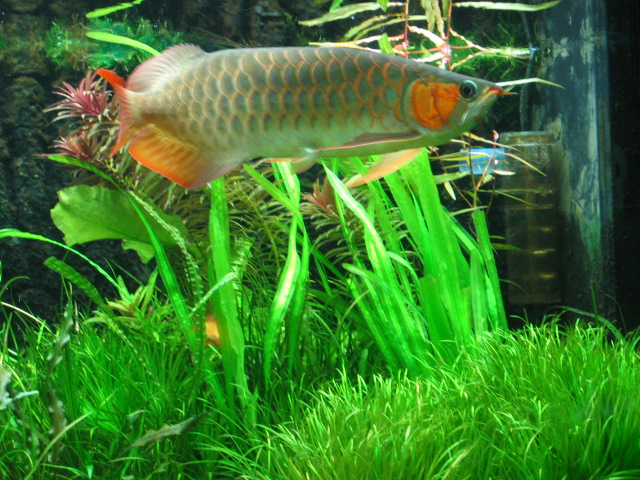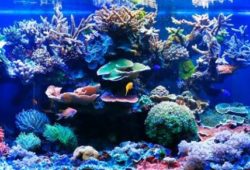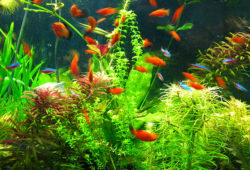Arowana Tank
In this article I’ll tell you about Arowana Tank. Arowanas are beautiful to behold. The proper arowana tank setup should always be considered before choosing your fish. Whether they are kept as a pet or prized as a collector’s item, arowana fish belong to the list of most popular of the large aquarium fishes.
Contrary to what most people think, raising an arowana is not that easy but with the right information and preparation having a healthy arowana tank can be accomplished. People invest a lot of time and money in breeding arowanas and raising them. However, this doesn’t stop ordinary hobbyists and collectors from still choosing arowanas over other kinds of fish.

One of the prerequisites in owning such fish is having the appropriate aquarium or arowana tank to serve as their home. The fish tank for an arowana may just be like the regular aquariums where fishes are kept as pets. What makes it different however are the specifications required to accommodate such a large fish. Here are the three main considerations in preparing an arowana tank which aquarists and hobbyists must keep in mind.
Contents
Choosing an Arowana Tank
A properly sized arowana tank size is important in keeping an arowana fish healthy. As a general rule, a tank size which can contain a minimum of 150-200 gallons is required. There may be a slight difference in fish tank size depending on the breed or arowana type to be kept. Jardini Arowanas are generally smaller compared to the other type of arowana, and so, a smaller tank may be used.
In comparison, a Silver Arowana can grow up to 35 inches long which calls for a larger tank. People who do not have enough space to put up an 8×3 aquarium can also settle for a 150 gallon aquarium. A tank of such size may do but is not considered as an ideal long-term size. Always use the largest volume of water that space will allow.
Some owners may opt to have a smaller tank to begin with as it can accommodate a young bonytongue though a change in tank size will be necessary once the fish reaches full maturity. When owners do otherwise, there is a big possibility that the arowana will grow unhealthy and may even develop deformities. Having an arowana fish tank with the right size will ensure that the fish will grow healthy, be free of deformities, and have a greater chance of reaching its maximum lifespan.
Tank Equipment for Large Fish
Getting the suitable equipment for your arowana tank is equally important. A complete set of filtering equipment, aerator, lighting, water and air pumps and heater is needed to keep the environment of the tank ideal for the arowana. The decay of uneaten food coupled with the arowana’s natural respiration process produce waste which can make the water polluted.
In order to get rid of the pollutants, an effective biological, mechanical and chemical filtration system must be in place to prevent the water quality from deteriorating. The aerator on the other hand ushers the natural exchange of much needed gases, namely oxygen. Through aeration and surface agitation, oxygen is infused with the tank water while carbon dioxide is removed.
The temperature of the water must be closely monitored using a thermometer and if there is any issue, the water temperature can be adjusted accordingly using the heater.
The presence of lighting equipment is also necessary. The most common lighting equipment used in an arowana fish tank is a fluorescent lamp because they enhance the color or the arowana’s scales, making them appear more lively and beautiful.
A siphon may also come in handy in getting rid of detritus and foreign material inside the tank while the use of top covers or lids is recommend as arowana’s tend to leap out of their tanks.
Water Condition
The quality of the water inside the tank must be closely monitored. There is a strict temperature and pH requirement for every arowana species. For example, the temperature for Silver Arowanas are best kept between 24 to 28 degrees celsius with a pH level of neutral or 6.0. Golden Arowanas prefer a temperature that lies between 24 to 30 degrees celsius and requires the pH of the water to be in between 7.0 to 7.5. The water temperature for the Jardini Arowana, on the other hand, must be between 22 to 27 degrees celsius while the water’s pH should be kept from 6.0 to 7.5.
On top of these temperature and pH requirements, the water should be kept clean and well-filtered. However, with the presence of the right equipment, having the right condition for your arowana pet can be ideally achieved though constant monitoring is still needed. After all, most arowana breeders and collectors say that the foremost virtue needed in successfully keeping an arowana is diligence.
Arowana Tank Setup Factors
Preparing the arowana tank doesn’t only require the addition of added equipment. The general environment of the tank, specifically the arowana tank concept, should also be customized to cater to the needs of the fish. The presence of substrate and aquatic plants, both artificial and live contribute to making an ideal habitat for the arowana. It wouldn’t hurt to have a decoration or two inside the tank as long as it is not going to harm the fish.
Though the arowana prefer to live a solitary life, there are a number of fishes which can live side by side with bonytongues. Add in a number of compatible fishes like oscars and tigerfish and the tank is prepared to hold the arowana as an ideal large fish for an aquarium.



